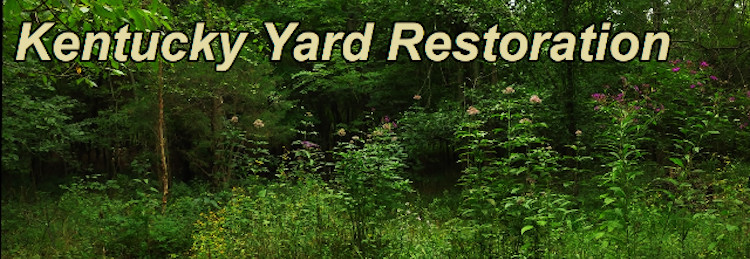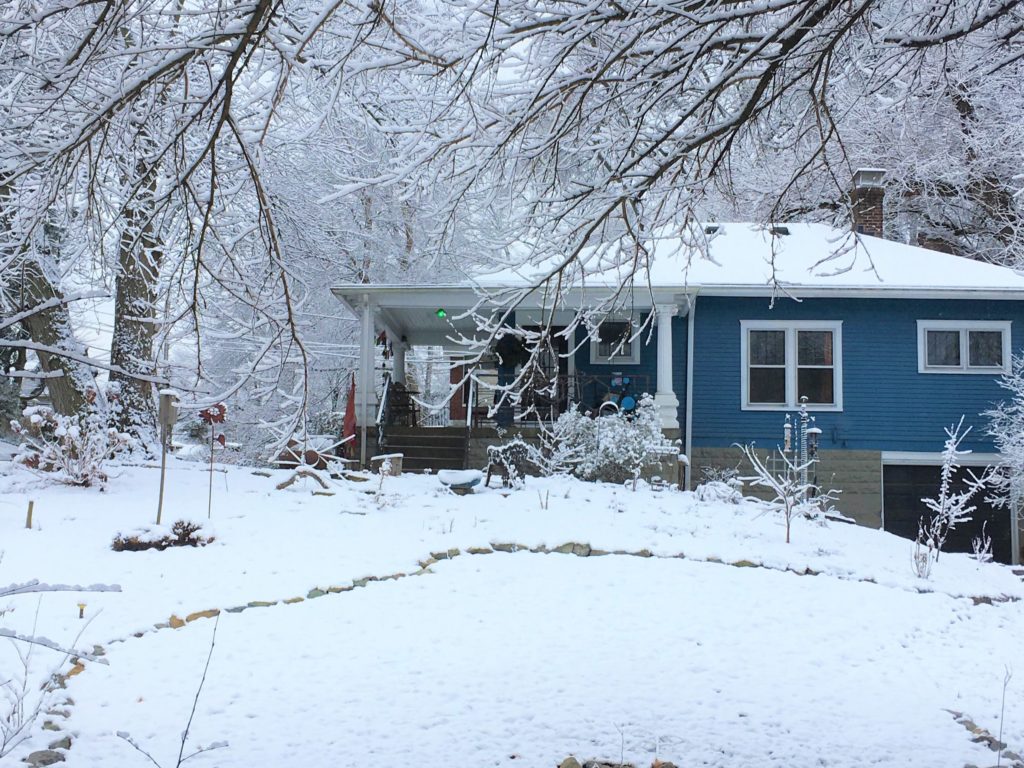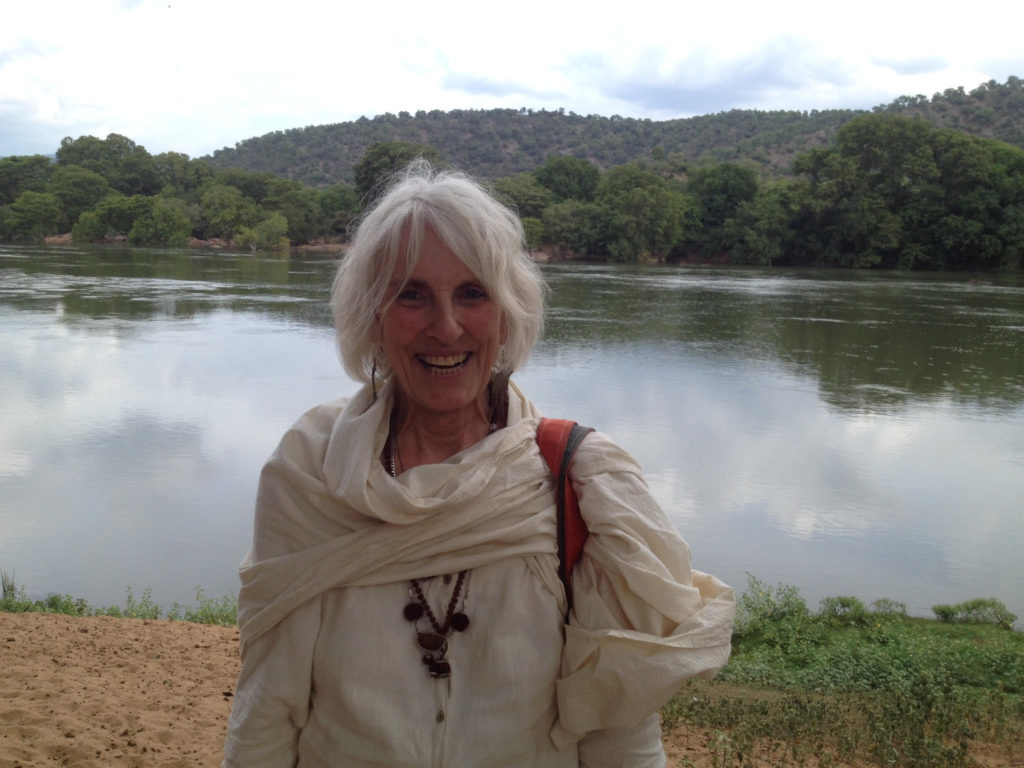
By Karen Cairns
In March of 2018, I moved into my home in Louisville, Kentucky. I had been living in apartments in Virginia for the past decade, taking care of ailing parents. I couldn’t wait to garden again! My new huge yard had three big trees (a white mulberry, a red mulberry, and a silver maple) and four bushes (two azaleas, an Oregon grape holly, and a winterberry), plus almost every kind of invasive, non-native plant.
The lawn was immense. I live on a busy corner and there were no trees or bushes to soften the view. Invasives were everywhere. The worst offender was the more than 20-foot-high bamboo, which had sent out roots everywhere—into all the neighbors’ yards, even coming up through concrete! The two mulberry trees were covered in English ivy, grapevine, and euonymus (winter creeper), as was the side of the house and the chain link fence on the south side. The vines had been there years—they had trunks as big as my arm.
An invasive plant is one that does not belong where it is growing, whose origins are foreign. A native plant, for instance, one that is native to Kentucky, belongs here. Native plants may become aggressive, growing out of bounds, but are never considered invasive. Invasives crowd out the native plants, which support wildlife, birds, and insects. Invasive vines, such as euonymus, can harm trees, pulling down limbs and weakening the tree. I am an environmental educator. It is important to me to support our local insects, the pollinators, who in turn support birds and the ecosystem. I knew I wanted to plant more native trees, plants, and bushes.
My first herculean task was to remove the invasive plants. I found a video from the Olmsted Conservancy about removal of euonymus, grapevine, and ivy, and I followed the instructions. My son and I cut each off at the ground level and pulled down as much as we could. I painted the cut roots with an herbicide—my only use of chemicals. I hired a lovely young man, who later bought a house near me, to dig out the bamboo, digging down many feet to get all the roots. These efforts took up most of my first year. But, wow, did it feel good when it worked and the trees, the fence, the yard were free of these hanging, strangling vines. I also dug up bin after bin of lily of the valley from under the red mulberry. Yeah, they smell great, but they spread by runners and choke everything else out.
Dividing my property into three sections made the task seem more manageable. The lot is about 7,000 square feet with about 936 square feet for the house. There was lawn that needed mowing on three sides, small areas on the east and south, huge area on the north side. I have a side garden on the south, a front garden on the east, and a huge lawn on the north. The bamboo was on the west where my back deck adjoins the neighbors’ property. That neighbor had horrible problems with the bamboo and their patio area. When the dreaded bamboo was gone, they redid their fence and planted some evergreens between their fence and my back deck.
I immediately did away with the parts that needed mowing on the east and the south, planting a native red honeysuckle that I could see from my bedroom window for hummingbird observation. I made the south area, which is fenced, into an herb garden and grew a few vegetables the first year. It was small enough that I could dig up invasives, including massive euonymus all over the fence, and rip up the plastic netting that the previous owners had put down for weed control (which didn’t work and left bits of plastic everywhere!). The front lawn, near the street, was easy to make non-lawn just with digging and mulching what had been lawn by the curb. I planted lavender there (a “comfort plant” for me). I dug up bag after bag, box after box of daylilies and iris from the front yard. I like these and, even though they are not native, they do not cause problems, but they hadn’t been thinned in ages. I gave most of these away to neighbors. I saved the daylilies that were the most beautiful and that were fragrant. And I kept some iris—didn’t everyone’s grandmother grow roses and irises?
The huge, empty lawn on the north side gave me pause; it seemed enormous and required mowing. Lawns do not support pollinators, birds, butterflies, and other wildlife. They are a contributor to climate change, whereas vegetable gardens and plants help the ecosystem and work against climate change. To save my sanity, I decided to divide it into sections and get rid of lawn in increments. First, I extended the skimpy side garden by a huge amount, putting down cardboard and newspaper, then wood chip mulch. The tree company left me an enormous pile of wood chip mulch (free) on the lawn near the curb after trimming a white mulberry. I put down cardboard from the grocery store, filled in any spaces/gaps with newspaper, then covered with a thick layer of mulch. I made a curved section all around the bend in the road, linking the red mulberry with the silver maple near the house, which I planted with trees and bushes to act as a buffer zone. Last year, I finally filled in a large section in the middle, which is going to be a “lawn” made of violets. Violets are one of the only things that grow through the cardboard and mulch! Violets are native and good for pollinators.




The first year I planted many plants that I consider “comfort” plants—ones that remind me of someone or someplace. Some of these were not native, but I was careful not to get anything “exotic” that was invasive, that would spread and cause problems. I planted two rose bushes and some Daphne for fragrance—exotic plants that don’t spread. From here on, though, it was all native plants, trees, and bushes for me and my garden kingdom!
Do you know the online community Next Door? I discovered their free postings and found concrete pavers, rocks, bricks, broken concrete pieces with stone. Using these I was able to mark out section by section that I was converting from lawn into garden. I think it looks great and I feel great using recycled materials for my eco-garden! I even got three free native inkberry bushes from Next Door! I outlined four vegetable gardens using old brick and broken concrete—planting asparagus in 2019. This year I am eating asparagus every day! (And my pee has got that great smell.)
The past three years, I have planted more than 20 native trees and bushes—most I got free from the tree give-away program in Louisville: persimmon, oak, Kentucky coffee-tree, redbud, tulip poplar, inkberry, persimmon, wild plum, etc. I am now on my third huge mulch pile—all free from local tree companies. I bought one native tree, a fringe tree, from a local native plant nursery, and each year I get a selection of plants from this nursery—witch hazel, spice bush, cardinal flower, etc.
Last year I discovered a Kentucky Native Plant Swap on Facebook for this area, started a few years ago by Anne Milligan and Stephen Brown. It is fabulous. We have a seed and plant swap going with mini-swaps for different areas in and around Louisville. They are such a great community of like-minded native plant folks!
I planted river oats where the lily of the valley used to be, and now I can share those seeds with others. I also share beautyberry seeds. I label most of my native trees, bushes, and plants—this is for me (I am 75 and my memory…well…) and because I see this as community education; people are often asking me what a particular plant is.
Mainly, I am planting natives that form “clumps,” as I prefer a relatively neat garden! And I am leaving the sections outlined with rocks for the same reason. One advantage of having no lawn, besides not mowing, is that leaves from trees fall wherever and don’t need raking. This also provides habitat for over-wintering pollinators, increases soil viability, and is generally better for the ecosystem. My goal is to have my “yard waste” only for pulled up invasives!
Besides my online community of native plant admirers, I also include my immediate neighborhood. My third year here began with Covid and quarantine. I worked in the yard and neighbors would be out walking. It was easy and fun to be outside, physically distant enough to be safe, yet to meet each other and talk. Most neighbors have been extremely interested and supportive. Several told me what they had started to do with their front yards. People asked me what different plants were. I put up a sign in the fall explaining the river oats and inviting people to collect seeds for their yards. Sure, there are some folks who are skeptical that this will “work,” and some who are disapproving: “You don’t want any lawn?” One sweet lady asked with a plaintive tone, “But what will it be?” An older man shook his head, “You’re in for a world of trouble, lady.” But most have been admiring, “It’s like a miniature Bernheim Forest,” “It’s like Yew Dell West!” (Yew Dell is a local nursery.) Some neighbors want starts of plants.

I wrote a small piece, like this one, for my community newsletter, giving my address and inviting people to stop by, which they do. There was one “hate letter,” unsigned, from someone who believes I am deluded about climate change and sees me as an “elitist snob,” but I try to explain to neighbors that I am not telling anyone else what to do and that any small step they want to try with natives is worthwhile and a lot of fun. I love this sense of community, especially during a pandemic and a political scene fraught with tension. Plants and being outdoors are so very healing, in so many ways. I have so much to be grateful for.

Karen Cairns, EdD, MPH, BSN, is an Ashtanga yoga practitioner and teacher, traveling to India each year for several months to be with her teachers there. After getting her doctorate in Environmental Education at the University of Louisville, she worked in the Department of Urban and Public Affairs. The past decade Karen lived in apartments in Virginia, taking care of parents, so she was very happy to move back to Louisville in 2018 and have a garden once again!
